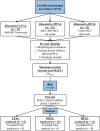Effects of different levels of physical activity on arterial stiffness and physical fitness performance in firefighters
- PMID: 39239544
- PMCID: PMC11373549
- DOI: 10.7150/ijms.96269
Effects of different levels of physical activity on arterial stiffness and physical fitness performance in firefighters
Abstract
Background: Firefighters have lower levels of physical activity while on call. It is critical to understand the impact of firefighters' physical activity on arterial stiffness. This study classified groups by physical activity level and combined peripheral vascular monitor measurement to explore the relationships between the level of physical activity and cardiovascular (CV) risk and physical fitness (PF) of firefighters, as well as the acute response to arterial stiffness (AS) following maximal aerobic exercise test (MAET) intervention. Methods: The International Physical Activity Questionnaire (IPAQ) was used to classify the participants into 3 groups: low, moderate, and high level of physical activity group, respectively. A total of 36 participants were recruited, 12 in each group. Participants were assessed for body composition, rest brachial-ankle pulse wave velocity (baPWV), handgrip strength (HGS), maximal oxygen uptake (V̇O2max), and MAET baPWV. Results: In the three groups, significant differences were observed in V̇O2max, HGS, relative fat mass (%FM), body mass index (BMI), muscle mass ratio (MMR), and Rest baPWV (p < 0.05). After maximal aerobic exercise, the MAET baPWV values decreased significantly in all groups (all p < 0.001). Rest baPWV was significantly correlated with firefighters' age, seniority, metabolic equivalents (METs), height and muscle mass (MM) (p < 0.05). Conclusions: Firefighters with high levels of physical activity had better body composition and physical fitness and lower Rest baPWV. In all three groups, baPWV was lower after the MAET than before it. Therefore, regardless of a firefighter's level of physical activity, high-intensity aerobic exercise may have a beneficial effect on arterial stiffness.
Keywords: arteriosclerosis; body composition; firefighter; physical training.
© The author(s).
Conflict of interest statement
Competing Interests: The authors have declared that no competing interest exists.
Figures


Similar articles
-
Impacts of aquatic walking on arterial stiffness, exercise tolerance, and physical function in patients with peripheral artery disease: a randomized clinical trial.J Appl Physiol (1985). 2019 Oct 1;127(4):940-949. doi: 10.1152/japplphysiol.00209.2019. Epub 2019 Aug 1. J Appl Physiol (1985). 2019. PMID: 31369328 Clinical Trial.
-
Association of cardio-ankle vascular index with physical fitness and cognitive symptoms in aging Finnish firefighters.Int Arch Occup Environ Health. 2012 May;85(4):397-403. doi: 10.1007/s00420-011-0681-0. Epub 2011 Jul 26. Int Arch Occup Environ Health. 2012. PMID: 21789686
-
[Comparison of arterial stiffness in non-hypertensive and hypertensive population of various age groups].Zhonghua Xin Xue Guan Bing Za Zhi. 2018 Jan 24;46(1):56-63. doi: 10.3760/cma.j.issn.0253-3758.2018.01.010. Zhonghua Xin Xue Guan Bing Za Zhi. 2018. PMID: 29374939 Chinese.
-
AST to ALT ratio and arterial stiffness in non-fatty liver Japanese population:a secondary analysis based on a cross-sectional study.Lipids Health Dis. 2018 Dec 3;17(1):275. doi: 10.1186/s12944-018-0920-4. Lipids Health Dis. 2018. PMID: 30509277 Free PMC article. Review.
-
Brachial-Ankle Pulse Wave Velocity and the Risk Prediction of Cardiovascular Disease: An Individual Participant Data Meta-Analysis.Hypertension. 2017 Jun;69(6):1045-1052. doi: 10.1161/HYPERTENSIONAHA.117.09097. Epub 2017 Apr 24. Hypertension. 2017. PMID: 28438905 Review.
Cited by
-
[Cluster predictors of trajectories of leisure-time physical activity intensity in men and women from ELSA-Brasil].Cad Saude Publica. 2025 May 19;41(4):e00132924. doi: 10.1590/0102-311XPT132924. eCollection 2025. Cad Saude Publica. 2025. PMID: 40396819 Free PMC article. Portuguese.
References
-
- Horn GP, Gutzmer S, Fahs CA. et al. Physiological Recovery from Firefighting Activities in Rehabilitation and Beyond. Prehosp Emerg Care. 2011;15:214–5. - PubMed
-
- Smith DL, DeBlois JP, Kales SN. et al. Cardiovascular Strain of Firefighting and the Risk of Sudden Cardiac Events. Exerc Sport Sci Rev. 2016;44(3):90–7. - PubMed
-
- Munir F, Clemes S, Houdmont J. et al. Overweight and obesity in UK firefighters. Occup Med (Lond) 2012;62(5):362–5. - PubMed
-
- Albert CM, Mittleman MA, Chae CU. et al. Triggering of sudden death from cardiac causes by vigorous exertion. N Engl J Med. 2000;343:1355–61. - PubMed
-
- Skinner TL, Kelly VG, Boytar AN. et al. Aviation rescue firefighters physical fitness and predictors of task performance. J Sci Med Sport. 2020;23:1228–33. - PubMed
MeSH terms
LinkOut - more resources
Full Text Sources
Medical
Research Materials
Miscellaneous

